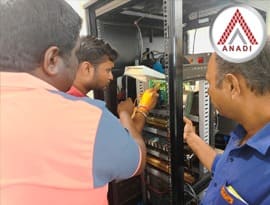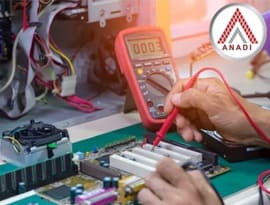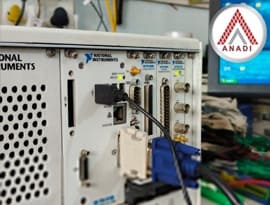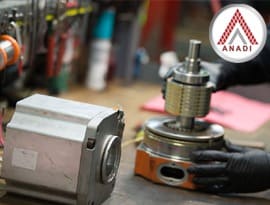- We Care, Production Should Not Stop.
- Home
- Hmi Repair Service
Professional HMI Repair Services – Fast, Reliable, Affordable
A faulty HMI can bring your entire operation to a standstill. When touchscreens stop responding, displays flicker, or communication fails, production slows—or stops entirely. We specialize in fast and dependable HMI repair services that restore your interface devices to like-new condition. Whether it’s a minor screen issue or a full system failure, our technicians can get your HMI up and running—saving you the cost of full replacement and minimizing downtime.
Our Successful HMI Repair Work
.webp)
Mitsubishi HMI Repair
.webp)
Siemens HMI IPCRepair
.webp)
Fuji 10" HMI Repair
.webp)
Siemens HMI Repair
Note: All repairs are handled by Anadi Automation with a warranty provided by us. This warranty does not come from Manufacturer, and we are not affiliated with any brands in providing this warranty
Why Choose Our HMI Repair Service?
-
🔧 Multi-Brand Expertise
From Allen-Bradley PanelView to Siemens, Pro-Face, and Schneider Electric—our team can repair a wide variety of HMI brands and models.
Note: We are an independent repair service provider and not affiliated with these brands. -
⚡ Fast Turnaround Times
We know downtime is expensive. That’s why we offer quick service, including rush repair options for urgent needs. -
🔎 Thorough Diagnostics
We don’t guess. Our team uses advanced tools to identify the root cause of the issue before starting any repair work. -
💰 Cost-Effective Solutions
Repairing your HMI is often more affordable than replacing it. We help you save money without sacrificing performance. -
🧪 Full Testing Before Return
Every repaired unit is tested under simulated working conditions to ensure it's 100% operational when it reaches you. -
🛡️ Warranty & Support
All our repairs come with a warranty by Anadi Automation and access to friendly, knowledgeable post-repair support.
(The warranty is provided solely by Anadi Automation and not by the original manufacturer.)
What We Repair
Our HMI repair services cover:
- Non-responsive or cracked touchscreens
- Dim, flickering, or blank displays
- Power supply issues
- Communication port failures
- Memory or data retention problems
- Faulty backlights or LEDs
- Damaged keypads or buttons
- Operating system/software issues
- Burnt or damaged circuit boards
We service HMIs used in manufacturing, packaging, robotics, energy, food & beverage, and more.
Common Causes of HMI Failures
HMI (Human Machine Interface) units are the critical link between operators and machines—when they fail, so does productivity. Over time, and with constant use, several factors can contribute to HMI malfunctions. Here are the most common causes we encounter during repairs:
The touchscreen is one of the most used parts of an HMI. Continuous tapping, pressure, or accidental impact can cause it to become unresponsive, cracked, or inaccurate. In industrial environments, it's not uncommon for screens to wear out from repeated use or rough handling. ● 🌡️ 2. Overheating and Poor Ventilation
HMIs generate heat, especially when operating for long hours. Without proper ventilation or cooling, internal components can overheat, leading to slow response, random shutdowns, or total failure. Units installed near machinery or in enclosed panels are especially vulnerable. ● 💾 3. Corrupted Firmware or Software Errors
Software glitches, corrupted firmware updates, or memory overload can prevent an HMI from booting properly or cause the interface to freeze. These issues often arise after failed updates or power interruptions during operation. ● ⚡ 4. Power Supply Fluctuations
Inconsistent power supply, voltage spikes, or surges can damage internal circuits or cause sudden shutdowns. Over time, even minor fluctuations can degrade sensitive electronic components. ● 🔌 5. Damaged Communication Ports
Faulty or worn-out communication ports (such as USB, RS232, or Ethernet) can prevent the HMI from communicating with PLCs or other devices, leading to data loss or process errors. This is often caused by frequent plug-ins or physical strain on connectors. ● 🧼 6. Contamination from Dust, Oil, or Moisture
Industrial environments are often harsh. Dust buildup, oil residue, and moisture can enter the unit and damage internal circuitry or cause screen fogging and corrosion. This is especially common in facilities without protective enclosures or filters. ● 🔄 7. Aging and Wear Over Time
Like any electronic device, HMIs degrade over time. Capacitors dry out, solder joints weaken, and internal screens lose brightness or become pixelated. Even well-maintained units may begin to fail after years of continuous use. ● 🧯 8. Improper Installation or Handling
Incorrect mounting, loose wiring, or exposure to electrostatic discharge (ESD) during installation can damage sensitive components before the HMI is even turned on. Mishandling during maintenance or transport can also cause internal or external damage.
Our HMI Repair Process
We keep things simple and transparent. Here’s how it works:
Ship or drop off your device—no paperwork hassle. 2️⃣ Inspection & Free Quote
We inspect the unit, identify the issue, and send you a no-obligation quote. 3️⃣ Repair & Replacement
We repair damaged components using quality parts and expert techniques. 4️⃣ Testing & Quality Check
Your HMI is tested under real-world conditions to ensure it's fully functional. 5️⃣ Return Shipping
Once approved, we ship your unit back safely and securely.
Our Other Repairing Services
Our Servo Drive Repair Process
Ship or drop off your unit at our repair facility. No diagnostics fee until you approve the quote. 2️⃣ Inspection & Diagnosis
We perform a complete analysis to identify faults and determine if repairs are feasible. 3️⃣ Free Quote
You’ll receive a clear, upfront quote. No work is done until you give the go-ahead. 4️⃣ Expert Repairs
Our technicians replace or repair faulty components using high-quality parts and proven techniques. 5️⃣ Functional Testing
The repaired drive is tested under simulated load conditions to ensure it performs to spec. 6️⃣ Return Shipping
Your servo drive is securely packaged and shipped back to you, ready to reinstall.
Frequently Asked Questions (FAQs)
(The warranty is provided solely by Anadi Automation and not by the original manufacturer.)




